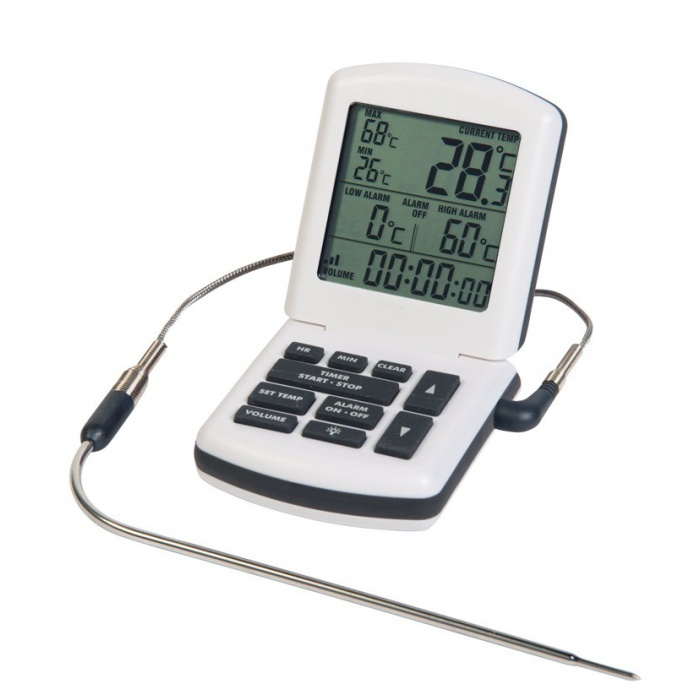Erreur de format d'e-mail
emailCannotEmpty
emailDoesExist
pwdLetterLimtTip
inconsistentPwd
pwdLetterLimtTip
inconsistentPwd


Mastering Culinary Precision: The Ultimate Guide to Using a Kitchen Thermometer with Probe
In the realm of culinary arts, precision is paramount. From perfectly cooked meats to delicate confections, achieving the ideal temperature can make all the difference. And when it comes to precision, a kitchen thermometer with a probe emerges as an indispensable tool for any chef or home cook. In this comprehensive guide, we will delve deep into the world of kitchen thermometers with probes, exploring their uses, benefits, and tips for mastering their art.
Why Choose a Kitchen Thermometer with Probe?
Before we delve into the intricacies of using a kitchen thermometer with a probe, let's understand why it's a game-changer in the kitchen.
1. Accurate Temperature Measurement: Unlike traditional instant-read thermometers, a kitchen thermometer with a probe provides precise temperature readings by allowing you to monitor the internal temperature of your food without opening the oven or grill.
2. Versatility: Whether you're grilling, roasting, baking, or sous vide cooking, a thermometer with a probe can handle it all. Its versatile design makes it suitable for a wide range of cooking methods and recipes.
3. Consistency: Consistency is key in cooking, and a thermometer with a probe ensures that your dishes turn out perfectly every time by eliminating guesswork and minimizing the risk of overcooking or undercooking.
4. Safety: By accurately measuring the internal temperature of your food, a kitchen thermometer with a probe helps prevent foodborne illnesses associated with undercooked meats and poultry.
Getting Started: Understanding Your Kitchen Thermometer with Probe
Before we dive into using a kitchen thermometer with a probe, let's familiarize ourselves with its components and features.
1. Probe: The probe is the heart of the thermometer, responsible for measuring the temperature of your food. It's usually made of heat-resistant materials like stainless steel and features a pointed tip for easy insertion into food.
2. Display Unit: The display unit is where you'll read the temperature readings. It may be attached to the probe via a wire or wireless connection, depending on the model.
3. Temperature Range: Different thermometers come with varying temperature ranges, so it's essential to choose one that suits your cooking needs. Some thermometers can measure temperatures from below freezing to searing hot.
4. Accuracy and Precision: Look for a thermometer that offers accurate and precise readings to ensure reliable results in your cooking endeavors.
Using Your Kitchen Thermometer with Probe: Tips and Techniques
Now that you're familiar with the basics, let's explore some tips and techniques for using your kitchen thermometer with a probe effectively.
1. Proper Placement: To get accurate temperature readings, insert the probe into the thickest part of the food, away from bones, fat, or gristle. For meats, aim for the center without touching bone or gristle, as they can skew the readings. This ensures that you're measuring the temperature at the coldest part of the food, giving you a more accurate representation of its doneness.
2. Avoiding Cross-Contamination: To prevent cross-contamination, clean and sanitize your thermometer probe before and after each use, especially when transitioning between different foods. This helps prevent the spread of harmful bacteria and ensures the safety of your food.
3. Monitoring Temperature Changes: Keep an eye on the temperature changes as your food cooks. This is particularly important for delicate dishes like custards or chocolate, where even a few degrees can make a significant difference. By monitoring the temperature closely, you can make adjustments to your cooking process to achieve the perfect result every time.
4. Calibration: Periodically calibrate your thermometer to ensure accuracy. Many models come with calibration features or can be calibrated using ice water or boiling water methods. This helps ensure that your thermometer is providing accurate readings, giving you confidence in your cooking.
5. Wireless vs. Wired: Consider whether you prefer a wireless or wired thermometer. Wireless models offer convenience and flexibility, allowing you to monitor temperatures remotely, while wired models may offer more accurate readings. Choose the option that best fits your cooking style and needs.
6. Understanding Temperature Targets: Different foods have different temperature targets for optimal doneness. Refer to cooking charts or guides to determine the ideal temperature for your dish. This ensures that your food is cooked to perfection, with the right balance of flavor and texture.
The Art of Perfect Cooking: Putting Your Thermometer to Use
Now that you're armed with knowledge, it's time to put your kitchen thermometer with probe to use in the kitchen.
1. Grilling: Achieve perfectly grilled meats by monitoring the internal temperature and ensuring they reach the desired doneness without overcooking. Whether you prefer rare, medium-rare, or well-done, a thermometer with a probe helps you achieve the perfect result every time.
2. Roasting: Roast meats and poultry to juicy perfection by tracking their internal temperature throughout the cooking process. This ensures that your roast is cooked evenly and retains its moisture, resulting in a tender and flavorful dish that will impress your guests.
3. Baking: Bake bread, cakes, and pastries with precision by monitoring the temperature of your oven and ensuring your creations are baked to perfection. Whether you're making a delicate soufflé or a hearty loaf of bread, a thermometer with a probe helps you achieve consistent results with ease.
4. Sous Vide Cooking: Take your sous vide cooking to the next level by using a thermometer to monitor water temperature and ensure precise cooking times for tender, flavorful results. Whether you're cooking steak, fish, or vegetables, a thermometer with a probe helps you achieve restaurant-quality results in the comfort of your own kitchen.
Conclusion
In conclusion, a kitchen thermometer with a probe is a versatile and indispensable tool for any culinary enthusiast. By mastering its use, you can elevate your cooking skills to new heights, achieving perfect results with confidence and precision. So, whether you're grilling, roasting, baking, or sous vide cooking, remember to reach for your trusty thermometer and cook with precision every time. Happy cooking!

